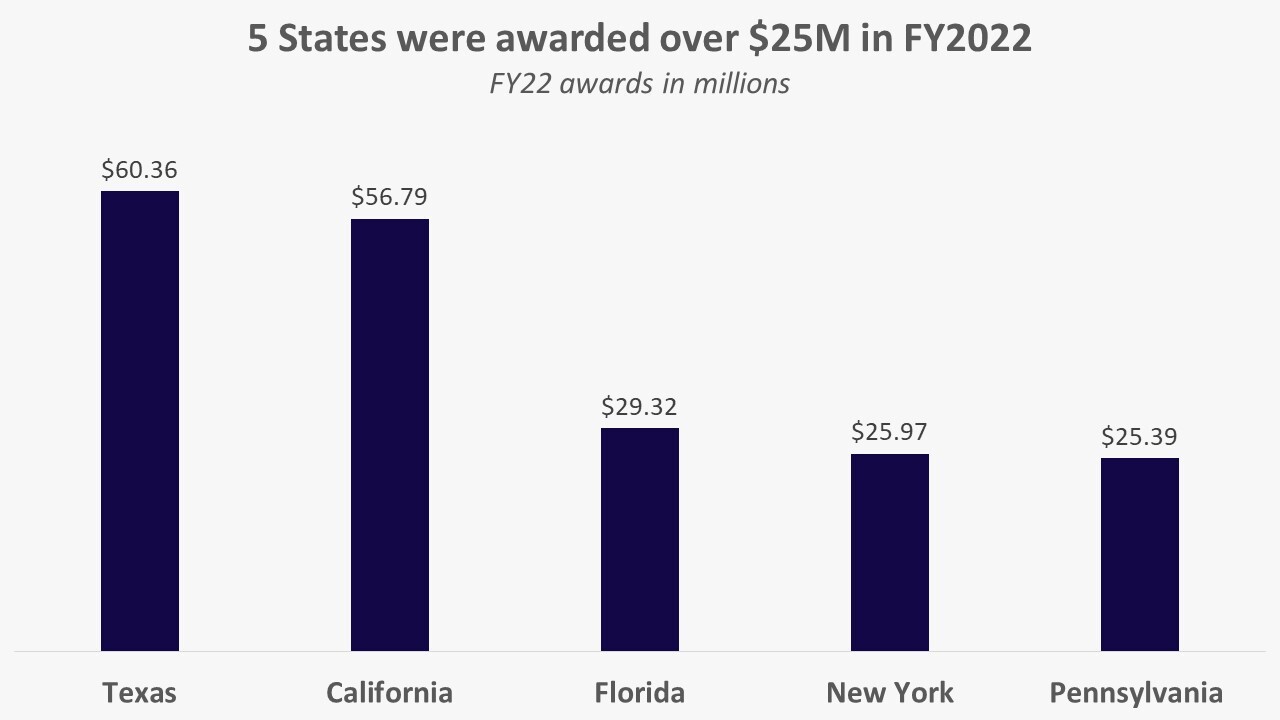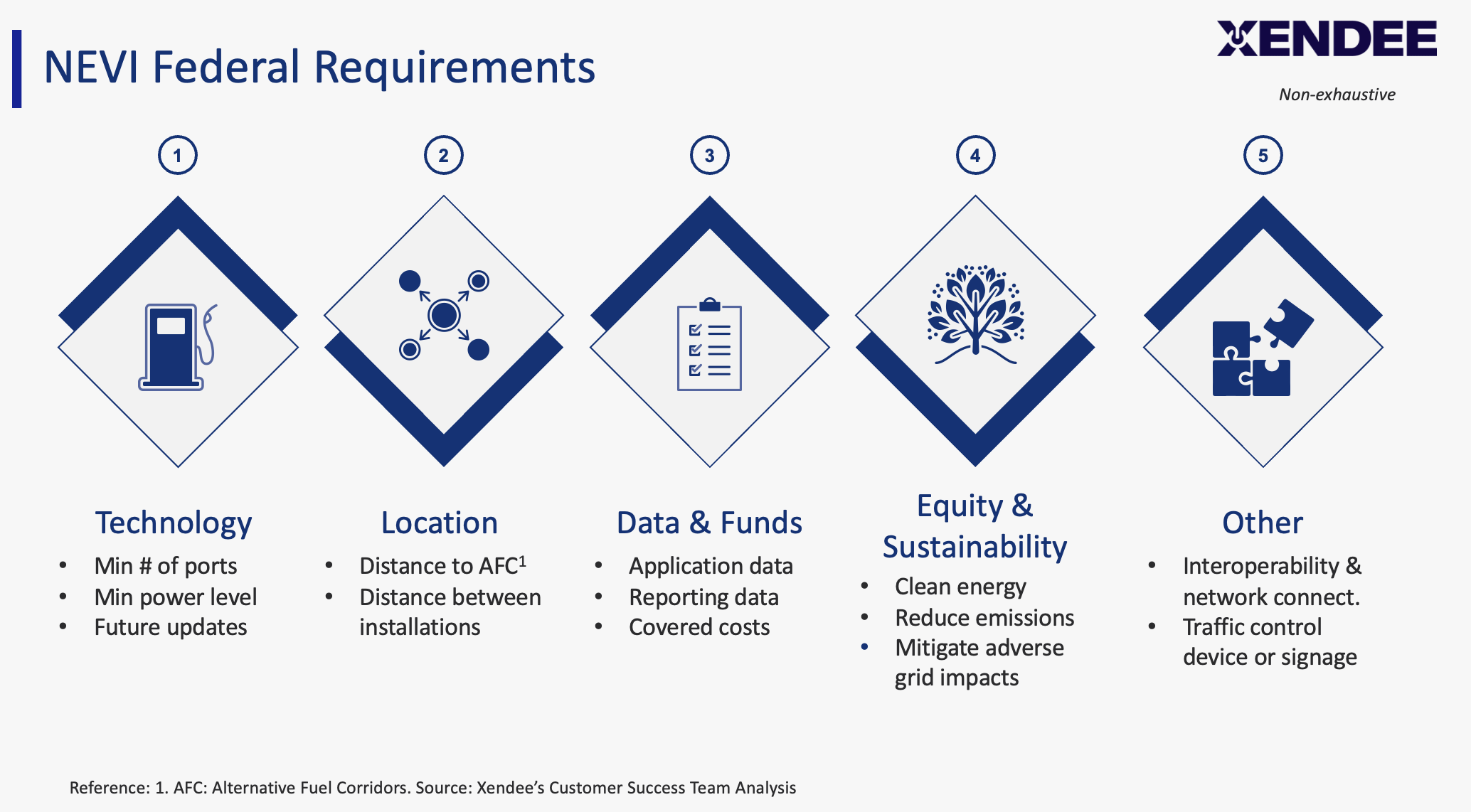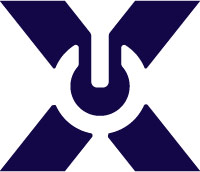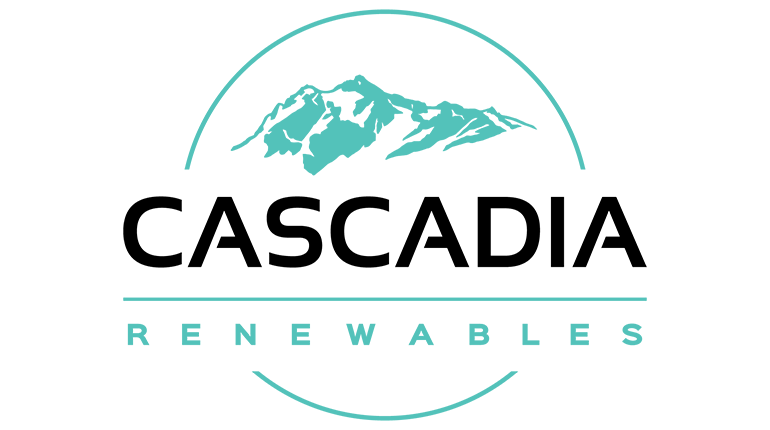The National Electric Vehicle Infrastructure (NEVI) program is a federally funded program that aims to allocate $5 billion over five years (2022 - 2026) to assist states in establishing a comprehensive network of public EV stations. The primary objective is to ensure a convenient, affordable, reliable, and equitable charging experience for all users.
In FY 2022 alone, $615 million was granted on a state-by-state basis, and an estimated $885 million is expected to be awarded in FY 2023 for electric vehicle infrastructure.
The NEVI funding program employs a competitive selection process, evaluating each state's plan for deploying Electric Vehicle Charging Infrastructure (EVCI), as well as their dedication to fostering EV adoption, and the potential impact of their projects on underserved communities. For detailed information on NEVI Funding by State, please click here.
In 2022, the following states were granted over $25 million each, based upon the program’s view of each state’s NEVI Plan1: (1) Texas: $60.36 million, (2) California: $56.79 million (3) Florida: $29.32 million (4) New York: $25.97 million (5) Pennsylvania: $25.39 million.

Once awarded federal funding, each state will provide grants to recipients through their own funding processes. These typically start with a Request for Information (RFI) which is used to inform the components of the proposal submission in the formal Request for Proposal (RFP). The funding is then allocated to submitted proposals based on each state’s criteria.
The state will fund public fast-charging projects with priority for those that are more economical and better support equitable adoption of EVs. NEVI funding recipients can get up to 80% of eligible project costs covered (find details here) 2. Some states have alternative funding and grant opportunities available too.
This presents an exceptional opportunity for EV industry participants to secure funding while contributing to the establishment of a robust nationwide network of EV chargers.

Applying to the NEVI funding program can be highly competitive, but this resource will lay out the challenges with the goal to help you streamline your proposal, ensure it meets the program's requirements, and get your application to stand out among the competition.
NEVI Funding Compliance Overview
As you look into the NEVI funding program, you'll encounter various federal and state requirements that must be met to ensure successful application submission.
Our expert team has analyzed this information and developed a comprehensive framework that summarizes five requirement areas as well as Xendee's capabilities in these 5 areas.
Below is a brief overview of our analysis.
- Technology: NEVI federal requirements include specifications such as the minimum number of ports, minimum power levels, and the ability to accommodate future updates. With Xendee, you can optimize the size and capacity of your technology, define optimal charging schedules, and forecast charging operations.
- Location: To comply with NEVI requirements, you must consider factors such as the distance to an Alternative Fuel Corridor, spacing between installations, and also present labeled site plans. Xendee simplifies this by measuring the distance from corridors, estimating available space for EV charging, and providing detailed diagrams and aerial views of your proposed sites.
- Data & Funds: The NEVI funding program requests application and reporting data, as well as cost and pricing considerations. Xendee equips you with the tools to provide comprehensive reporting, including detailed cash flow analysis, utility data, energy balance assessments, and optimized Charging-as-a-Service (CaaS) models, ensuring your application stands out and demonstrates financial viability.
- Equity & Sustainability: Meeting federal requirements related to reducing emissions and mitigating adverse grid impacts is crucial for a successful NEVI application. Xendee allows you to evaluate the environmental impact of your project and conduct a time series analysis of CO2 emissions, empowering you to showcase your commitment to sustainability and grid resilience.
- Other: Impacts on existing infrastructure, interoperability, and network connectivity, as well as traffic control and signage, are additional federal requirements to consider. Xendee can help alleviate adverse grid impacts by reducing peak demand and evaluating the effects of short circuits, ensuring your proposal addresses these crucial aspects.

1. Technology
Specific technical specifications must be met as part of the NEVI funding program.
- Have a minimum number of ports (four) and power level (150-kW per port)
- Determine the optimal size & capacity of the charging station, considering minimum requirements, and designing a system that maximizes efficiency.
- Reduce peak demand, minimize project’s cost & protect the grid
- Design for future updates
With the Xendee, you can validate/optimize your project to meet these federal technology requirements:
- Optimize for: (i) cost saving (ii) CO2 reduction (iii) both (Xendee’s multi-objective optimization)
- Optimize charging operations based on expected changes in demand, charging infrastructure, and energy prices over time (Xendee’s multi-year optimization)
- Predict future carbon taxes and develop strategies, inc. renewable energy installation and upgrades to (i) Reduce carbon emissions (ii) Facilitate expansion/upgrading of the charging infrastructure.
In addition to the federal requirements of the NEVI program, Xendee is equipped to assist with the specific needs of NEVI funding by states. Take, for example, Colorado:
- Consider technologies such as BESS (inc. cost-effectiveness)
- Determine the optimal size for the BESS, leveraging Xendee's software, considering factors such as load profiles, renewable energy generation, and grid constraints
- Dispatch energy storage based on the sub-hourly electricity prices to reduce the overall consumption, peak demand, and the need for backup generators
Xendee considers batteries to meet requirements and incentives and designs a system where the storage technology is optimized for overall performance.
2. Location
As part of applying to the NEVI funds program, there are specific location requirements that need to be met. Here are some of the location-related rules that NEVI involves:
- Comply with designated corridor constraints – including distance from AFCs and between stations3
- Consider spacing for potential future expansion
- Include an aerial photo of the site
- Create a labeled site plan that identifies the location of charging equipment
And here's how Xendee can assist in meeting these demands:
- Measure the site’s distance to corridors in the interface4
- Estimate/restrict available space to plan EV system
- Xendee’s aerial view of the site
- Visual representation of optimized EV charging infrastructure layout
3. Data & Funds
Below are the Data & Funds requirements that need to be met to qualify for the NEVI funds program. The former relates to the information you’ll submit during the application process, and the latter refers to certain specifications regarding covered costs.
- NEVI Funding is available for up to 80% of eligible project costs5
- Buy America Compliance6
- Create an itemized spreadsheet of all project costs (inc. acquisition and installation costs, maintenance & repair costs, and costs paid to the utility) and pricing structure
With Xendee you are able to:
- Define how much of your costs will be covered by the program and which costs the applicant will have to cover
- Inform the precedence of the technologies
- Technology Investment and energy balance charts, inc. Interest Rate, LCoE, ROI, Break Even, Payback period, NPV, Optimized CaaS, Bill of Materials, Cash flow
- Detailed Cash flow includes costs (electricity, installation, and maintenance costs, etc) and revenue (charging fees, utility incentives, and grants, etc)
4. Equity and Sustainability
The NEVI funds program promotes equity and sustainability. Although it doesn't impose specific requirements, Still, the program's goal is to achieve a clean energy future and guide the U.S. towards net-zero emissions.

Each state expresses its own Equity and Sustainability requirement expectations. Colorado, for example, asks applicants to include any measures taken to reduce and manage utility demand charges, offset on-peak electricity usage, and mitigate other adverse grid impacts while ensuring a positive charging experience.7
Xendee can run the analysis and report on this in the following ways :
- Run CO2 reduction optimizations and net zero solution
- Design & optimize microgrid for on-site generation, inc. clean energy generation & storage technologies
- Evaluate the environmental impact of EV charging infrastructure inc. carbon emissions, energy consumption, and renewable energy integration
- Analyze CO2 emissions on an hourly basis
5. Other Reporting
There are other NEVI funding requirements that need to be considered, including mitigating adverse grid impacts.
Xendee not only designs systems that reduce grid consumption during periods of peak demand (helping to alleviate adverse grid impacts) but also has features for you to evaluate the effects of short circuits. These are all considerations you can attach to your application submission and reporting.
- Perform power flow analysis and simulate short circuits to evaluate the effects of turning different technologies on/off
- Create one-line diagrams and develop optimized circuit designs
We encourage you to continue to explore the NEVI program. If you have any questions regarding these or any other requirements please email us at success@xendee.com.
Footnotes:
1. Source: Federal Highway Administration - Department of Transportation.
2. Apart from the 20% Non-Federal Match requirement, applicants need to follow Buy America, which requires that any products used in a federally funded project must be made in the United States. As for the costs, most costs directly related to EV charging are eligible, inc.: DCFC chargers, power conversion hardware, associated equipment/warranties, networking and data plans, SLA, and utility upgrades, dedicated solar and storage equipment, associated labor costs, future-proofing measures. Note that operating and maintenance costs are not eligible.
3. No more than one driving mile from (i) any point along a non-limited access AFC (ii) the end of the nearest designated AFC off-ramp; No more than 50 miles driving distance between charging stations.
4. Note that Xendee can be used to manually draw and estimate the location of a potential site, it has no information on HWY.
5. NEVI funding covers costs related to acquisition, installation, and network connection - including DCFC chargers, power conversion hardware, associated equipment/warranties, networking and data plans, SLA, and utility upgrades, dedicated solar and storage equipment, associated labor costs other hard costs, future-proofing measures.
6. Requires that any products used in a federally funded project must be made in the United States.
7. These may include but are not limited to, renewable DER and integration, storage, charge management strategies to mitigate on-peak electricity demand, innovative business models that lead to reduced equipment and installation costs, or reduced operation and maintenance costs. The incorporation of battery storage to reduce emissions, expedite project timelines or provide resiliency to the stations on-site should be clearly addressed.
 Xendee
Xendee







